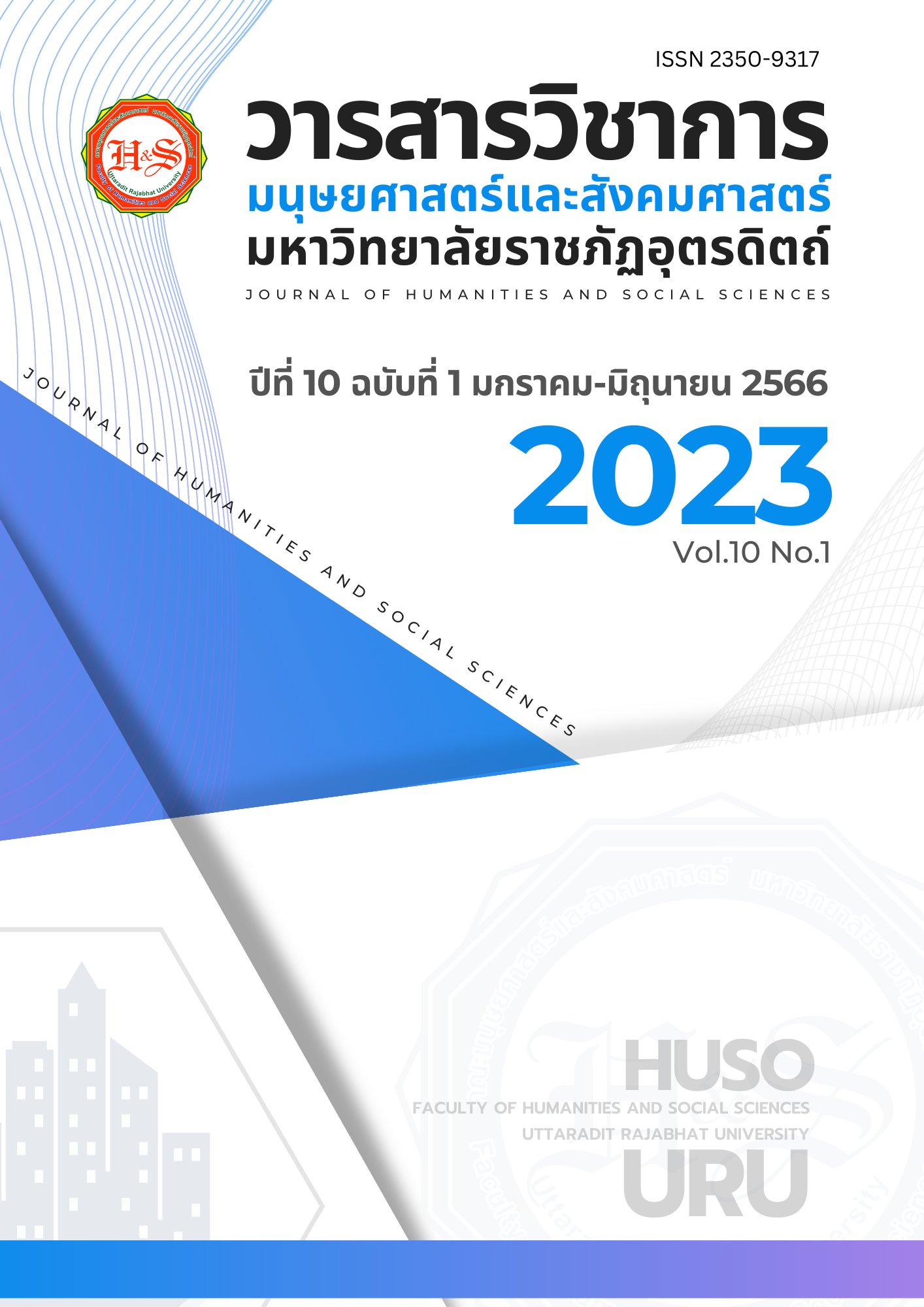The Creation of English Tourism Route Guidebook to Promote Tourism In Sisaket Province
Keywords:
Tourism Routes Guidebook, Components, Connection, Tourism, Sisaket ProvinceAbstract
The research “The Creation of English Tourism Routes Guidebook to Promote Tourism in Sisaket Province” aimed to study the components and connections of tourism in Sisaket Province and to create an English tourism routes guidebook to promote tourism in Sisaket Province. The researcher collected data from 30 samples selected by purposive sampling method divided into two groups: 1) five key informants and 2) twenty-five foreign tourists.
The research findings on the components and connections of tourism in Sisaket Province revealed that there were several natural, historical, and cultural tourist attractions in many districts. The three main components led to connections of tourism routes. In contrast, the information on tourism and services, management, and publicity did not attract both Thai and foreign tourists due to the limitation of staff and budget used to support the publicity. In addition, there were very few tourism guidebooks and documents in English language providing information and routes related to tourism in each tourist place.
According to the study of the components and connections of the 17 major tourist attractions in Sisaket Province, they were divided into four routes. The researcher collected and improved data based on comments from the experts and users. The evaluation results showed an average of 4.14 from the experts and 4.16 from the users. Both of them were at a high level. The researcher created English tourism routes guidebook providing information about itinerary, restaurants, souvenirs, accommodation, and recommendations on traveling along each route, including the tourism routes linking to natural tourist attractions which represented the various forms of beauty in the landscapes. Moreover, it presented the historical and archeological sites which represented the local history, art, and culture of each community.
References
เอกสารอ้างอิง
กระทรวงการท่องเที่ยวและกีฬา. (2548, 19 มกราคม). ยุทธศาสตร์การท่องเที่ยว พ.ศ. 2547-
https://www.mots.go.th/more_news_new.php?cid=411.
กัลยานี กุลชัย. (2561). แนวทางการสร้างเส้นทางท่องเที่ยวเชื่อมโยงเครือข่ายการท่องเที่ยว
ชุมชนโดยการมีส่วนร่วมของชุมชน ในพื้นที่ปากแม่น้ำเจ้าพระยา จังหวัด
สมุทรปราการ. วารสารสังคมศาสตร์ มหาวิทยาลัยศรีนครินทรวิโรฒ, 21(21).
การท่องเที่ยวแห่งประเทศไทย. (2544). แผนปฏิบัติการการท่องเที่ยวเชิงอนุรักษ์แห่งชาติ. การ
ท่องเที่ยวกองอนุรักษ์.
_______. (2547). ททท. การท่องเที่ยว. การท่องเที่ยวแห่งประเทศไทย.
ขวัญฤทัย เดชทองคํา. (2563). ความสําคัญของคุณภาพการบริการสู่ความสําเร็จของธุรกิจท่อง
เที่ยวภายใต้วิกฤติ Covid 19. วารสารวิทยาศาสตร์การกีฬาและสุขภาพ, 21(3).
ธันยพงศ์ สารรัตน์ และคณะ. (2561). แนวทางการจัดการการท่องเที่ยวทางวัฒนธรรมบ้านหว้าน
จังหวัดศรีสะเกษ. วารสารการบริหารการปกครองและนวัตกรรมท้องถิ่น, 2(3).
นนทิภัค เพียรโรจน์ และคณะ. (2558). การเชื่อมโยงเส้นทางและการส่งเสริมการตลาดโปรแกรม
การท่องเที่ยวเชิงประวัติศาสตร์และวัฒนธรรมของกลุ่ม 4 จังหวัดในภาคใต้ของ
ประเทศไทย. วารสารวิทยาการจัดการ, 32(2).
บุญชม ศรีสะอาด. (2535). หลักการวิจัยเบื้องต้น (พิมพ์ครั้งที่ 3). สุวีริยาสาส์น.
บุญเลิศ จิตตั้งวัฒนา. (2548). การพัฒนาการท่องเที่ยวแบบยั่งยืน. เพรส แอนด์ ดีไซน์.
ปิรันธ์ ชินโชติ และธีระวัฒน์ จันทึก. (2559). รูปแบบการจัดการการท่องเที่ยวเชิงสร้างสรรค์ของ
สวนผึ้ง. Veridian E-Journal, Silpakorn University, 9(1), 250-268.
แผนพัฒนาจังหวัดศรีสะเกษ. (2563, 11 ธันวาคม). แผนพัฒนาจังหวัดศรีสะเกษฉบับทบทวนปี
(2561-2565).
https://drive.google.com/d/1tc7dUuMaKCQLMVHxps4ppn5pOLrC-
Ju7/view
พิมพ์ระวี โรจน์รุ่งสัตย์ และคณะ. (2554). การสร้างคู่มือสําหรับมัคคุเทศก์เพื่อแหล่งท่องเที่ยว
ประวัติศาสตร์ กรณีศึกษาอุทยานประวัติศาสตร์พระนครคีรี จังหวัดเพชรบุรี. วารสาร
วิชาการ มหาวิทยาลัยราชภัฏพระนคร, 4(2).
ภูริวัจน์ เดชอุ่ม. (2556). การพัฒนาการท่องเที่ยวเชิงสร้างสรรค์: กรอบแนวคิดสู่แนวทางปฏิบัติ
สําหรับประเทศไทย. วารสารมหาวิทยาลัยศิลปากรฉบับภาษาไทย, 33(2), 331-
ศิริเพ็ญ ดาบเพชร. (2561). องค์ประกอบการท่องเที่ยวและช่องทางการสื่อสารภาพลักษณ์การ
ท่องเที่ยวสําหรับกลุ่มนักท่องเที่ยวอนาคต กรณีศึกษาจังหวัดพิษณุโลก. วารสารการ
วิจัยเพื่อพัฒนาชุมชน (มนุษยศาสตร์และสังคมศาสตร์), 11(1), 79-98.
สํานักงานคณะกรรมการพัฒนาการเศรษฐกิจและสังคมแห่งชาติ. (2545). แผนพัฒนาเศรษฐกิจ
และสังคมแห่งชาติ ฉบับที่ 9 (2545-2549). สํานักงานคณะกรรมการพัฒนาการ
เศรษฐกิจและสังคมแห่งชาติ.
สำนักงานปลัดกระทรวงการท่องเที่ยวและกีฬา. (2563). โครงการค่าใช้จ่ายสำหรับสำรวจ
ทัศนคติและความพึงพอใจของนักท่องเที่ยวชาวไทยและชาวต่างชาติที่เดินทาง
ท่องเที่ยวในประเทศไทย, รายงานผลความพึงพอใจการเดินทางท่องเที่ยวในจังหวัด
ศรีสะเกษ ปี 2563. สำนักงานปลัดกระทรวงการท่องเที่ยวและกีฬา.
สุดแดน วิสุทธิลักษณ์ และคณะ. (2554). การท่องเที่ยวเชิงสร้างสรรค์ (Creative Tourism).
องค์การบริหารการพัฒนาพื้นที่พิเศษเพื่อการท่องเที่ยวอย่างยั่งยืน (องค์การ
มหาชน).
อุดมลักษณ์ เพ็งนรพัฒน์. (2560). ยุทธศาสตร์การพัฒนาศักยภาพการท่องเที่ยวเชิงวัฒนธรรม
จังหวัดศรีสะเกษ. วารสารการบริการและการท่องเที่ยวไทย, 12(2).
Ministry of Tourism & Sports. (2005, January 17). Tourism Statistics.
https://www.mots.go.th/more_news_new.php?cid=411.
Richards, G. (2009). Creative Tourism and Local Development. In: Wurzburger, R.,
Pattakos, A. and Pratt, S. (eds) Creative Tourism: A Global
Conversation. Santa Fe Sunstone Press.
______. (2011). Creativity and Tourism: the State of the Art Annals of Tourism
Research. Annals of Tourism Research, 38(4), 1225-1253.
Tourism Marketing Strategy Division. (2016). TAT Review Thailand Tourism in
Thailand as a Preferred Destination. E-Journal of Applied, 4(4).
World Tourism Organization (UNWTO). (2005, January 19). Sustainable
Development of Tourism. http://sdt.unwto.org/en/content/about-us-
d
Downloads
Published
How to Cite
Issue
Section
License
Copyright (c) 2023 Journal of Humanities and Social Sciences Uttaradit Rajabhat University

This work is licensed under a Creative Commons Attribution-NonCommercial-NoDerivatives 4.0 International License.
บทความเป็นลิขสิทธิของคณะมส. มรภ อต.



